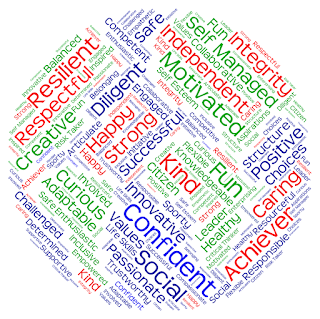#hackyrclass2 - SOLO in action
This week saw my Level 1 students put their SOLO work in to action. I started off by giving them a SOLO grid of learning activities that match the SOLO learning outcomes. My hope is that they will start to find and share learning activities themselves when they become more familiar with the taxonomy.
We talked about using the unit plan to decide where they were in their learning, what the did and didn't understand. They then self-selected activities to consolidate their understanding, and then challenge themselves to a higher level.
Building DNA with lollies proved to be a popular activity choice (go figure!). How they shared their justification of lolly choice and manipulation was up to them. One group chose a static image:
We talked about using the unit plan to decide where they were in their learning, what the did and didn't understand. They then self-selected activities to consolidate their understanding, and then challenge themselves to a higher level.
Building DNA with lollies proved to be a popular activity choice (go figure!). How they shared their justification of lolly choice and manipulation was up to them. One group chose a static image:
Another group use iLapse on an iPad to film the building and then replication of DNA
When I asked this group to justify their process and link it to the actual biology process, so working in the extended abstract, this is what they wrote:
We used green wine gums to represent the original phosphate. we choose the wine gum as the phosphate as it had a circular shape which best represented the the actual shape of the phosphate molecule. The pineapple lumps were chosen as the sugars because they were the best lolly to cut up and show the antiparallel structure of the DNA. We cut each pineapple lump an arrow at one end so that one strand of DNA could have the arrow facing upwards and the other strand could have it facing downwards. We then chose the starbursts to represent the bases as there were four colours meaning that we could use each colour to represent a different base, pink was C and was paired with the red starburst which was G. The purple one was A and the blue starburst was T. Using the different colours to symbolise the bases was the easiest way to show the base pairing rule. We started off by making the first base pair. we put a ‘phosphate’ on the paper and then connected it with a ‘sugar’ with the arrow facing upwards. the arrow of the ‘sugar’ symbolises the top of the sugar. We then joined a ‘C’ base to now connected sugar phosphate. To complete the base pair. we then joined a ‘G’ base to the ‘C’ base and a ‘sugar’ to the other side with the arrow facing downwards. we then joined another ‘phosphate’ to the top of the ‘sugar’ to complete the first base pair. We repeated this until we had a seven base pair section of lolly DNA which had a mixture of red and pink starbursts and blue and purple starbursts, showing that the DNA had a mixture of both base pairs. Before the strands started to split, we had an exact amount of the new ‘sugar’, ‘phosphate’ and ‘base pair’ ready to form the new strand the new strand. We did this because for a short time in the nucleus there are free nucleotides ready to form the new strand of DNA. We then started to split the two strands of DNA from the bottom up to demonstrate the first steps of DNA replication. We split the old molecule of DNA into two strands as the splitting process is semi conservative, meaning it saves the old strands so its easier for the new strands to form and it uses less energy. To represent the new strands of DNA which is being formed, we used a yellow wine gum as the new phosphate. The easily shows the old and new strands of DNA formed in DNA replication. While splitting the base pairs, we added a new ‘sugar’, a new ‘phosphate’ and a new ‘base’ to form a new base pair which is complementary DNA. We continued this until we had two identical and complete molecules of DNA made up of one old strand and one new strand. The two molecules formed have to be identical to ensure that the cells have the information to complete the same life functions as its parent cell.
I have never had students at this level be able to articulate their understanding so clearly, and I think it comes down to them being engaged with the activity, owning their learning, working collaboratively, understanding where they are in the process and being challenged to justify what and how they've learned, all in a safe and supportive environment.
Thank you for the #hackyrclass challenge Claire, and for championing the movement Steve. While I am getting so much from this, my students are the ultimate beneficiaries and for that I am truly grateful.



Hey Mrs Moore,
ReplyDeleteThis is not the one that I had read, so I was slightly excited to find this latest installment. Loving the engagement of your students.
I shall continue to stalk your great work!
Mrs Rakena